by Amineddoleh & Associates LLC | Jan 5, 2024 |
Sotheby’s has had a rocky start to 2024 . The New York Times reports that the auction house is preparing to defend itself in trial next week, in the most high-profile lawsuit the art world has seen since in over a decade.

One of the works Rybololev purchased. Tête by Modigliani. Image via Sotheby’s.com.
Facts of the Case
A Russian oligarch, Dmitry Ryboloblev, is accusing Sotheby’s of aiding in fraud. The trial is based on transactions Sotheby’s oversaw between Rybolobev and a dealer/advisor named Yves Bouvier. Bouvier has been accused of secretly acting as both an art dealer and owner of works he sold to Rybolobev, while Bouvier also represented himself as an art advisor. According to Ryboloblev, playing multiple roles enabled Bouvier to dramatically inflate the estimated value of any art sold, and pocket the difference.
Sotheby’s has been accused of helping Bouvier in his deception. The auction house has been accused of knowing that Bouvier lied to Rybolobev about the price of the artwork that Bouvier paid for it, and then helping Bouvier to adjust the work’s valuation accordingly. It will be difficult to prove that Sotheby’s knew that Bouvier was lying to his client, Rybolovlev. However, the evidence presented at trial could convince a jury that Sotheby’s representatives knew Bouvier was inflating the estimated value of the artwork being sold.
The most damning evidence is (as it always is) found in the digital breadcrumbs: certain emails admitted into evidence indicate that Sotheby’s representatives might have altered their valuations based on Bouvier’s instructions –allowing them to both profit from the difference.
Founder Sought as Expert Voice
The lawsuit may expose some of the secrecy behind the world’s most expensive art dealings, primarily because it involves a jury trial. The entire art world is abuzz with intrigue about the trial, and our founder, Leila, was sought out as an expert voice on this incredibly hot topic.
Leila was quoted in The New York Times, stating “There is so much secrecy in the art world that buyers sometimes don’t know the amount of money being made by others in transactions. . . this case will help to clarify the responsibilities and fiduciary duties owed to clients by dealers and auction houses.”
Anonymity in the Art Market
Our firm previously wrote about the issues stemming from anonymity in the art market here. This new case is expected to further increase transparency around those issues in the art market. It asks difficult questions about where loyalties lie when expectations become blurred and prices shoot sky-high. Another outcome for this trial could be fewer money-laundering schemes hidden in art transactions, because more transparency would give bad actors fewer places to hide.
No matter how this case ends, this trial will be one to watch: it has the potential to initiate a complete overhaul of centuries-old industry practices for art buyers, sellers, auction houses, and dealers around the world.
by Amineddoleh & Associates LLC | Dec 10, 2023 |
In our annual holiday newsletter, Amineddoleh & Associates is pleased to share some of the major developments that took place at our firm and in the art market during 2023. We had a banner year, as we were grateful to work with many returning clients, as well as new ones, including museums, collectors, galleries, artists, and entrepreneurs. We are pleased to share some holiday JOY from us to you.

Grand Central Station. Image courtesy of NannFilms, used with permission.
CLIENTS AND REPRESENTATIVE MATTERS
Hiroshi Sugimoto’s Point of Infinity
Our firm proudly announced the public art unveiling of our esteemed client Hiroshi Sugimoto’s Point of Infinity. The gravity-defying sculpture maintains an optical illusion that the two points of the work will (eventually, even if only in the viewer’s minds’ eye) meet. It is a testament to the genius of Sugimoto as an artistic force. Read more here.
Client Acquires Master Drawings in New York
We proudly represented our client Christopher Bishop and his eponymous Christopher Bishop Fine Art in the acquisition of the art fair Master Drawings in New York. The fair, held annually in January in New York City, focuses on works on paper and features several important galleries, as well as programs with leading institutions. Interested in attending the 2024 event? Mark your calendars for opening day on January 27th. Read more here.
Client Opens New Gallery Space
Our firm was pleased to work with Atamian-Hovsepian Curatorial Practice as it transitioned from freelance curating to unveiling its own inaugural gallery and exhibition space in New York City, focusing on underrepresented artists.
Antiquities Restitutions
Amineddoleh & Associates was involved in a number of cultural heritage restitutions this year, including the return of a valuable marble statue to its country of origin and the return of a collection of historic artifacts to their home overseas.

Snow-covered cabin. Artwork courtesy of Justin Leitner, used with permission.
ART & IP NEWS
One thing we love about the art market is that there is always something unexpected and exciting happening in the art world. Read on for a glimpse at some of our most popular blog posts this past year.
Commercialism v. Transformativeness
In this blog post, our firm examined shifts in copyright law following the decision in Andy Warhol Foundation for the Visual Arts, Inc. v. Goldsmith, et al. This highly-anticipated Supreme Court decision involved application of the fair use test (a test used to determine whether the use of a copyrighted work may be used without permission) to a case with peculiar facts: a photographer (Goldsmith) provided a limited license through Vanity Fair that allowed another artist (Warhol) to use her photograph to create a silkscreen work. Warhol violated the terms of the license, and trouble ensued. Legal scholars hoped that the decision would provide clarification on the test. Unfortunately, the high court’s opinion did not provide much guidance. Curious as to why? Read more here.
Wise Women in Art & Entrepreneurship
Ever wonder where all the great women artists were in your art history lectures? At Amineddoleh & Assoc., we did, too. In honor of International Women’s Day, our firm took a closer look at some of the most talented and undercelebrated women artists in history. We also highlighted our friends at Building 180 – a standout, full-service global art production and consulting agency filling the gap between artists and businesses to create public and private art installations. Read more on our website.
Armenian Cultural Heritage at Risk
Our firm took an exclusive look at the Armenian cultural heritage at risk due to aggression from the Azerbaijani regime. The exodus of Armenians and Azerbaijan’s occupation of Artsakh left Armenian art and architecture unprotected. Artsakh is known as the “Crown Jewel” of Armenian cultural heritage, as it contains some of the most exemplary representations of medieval Armenian architecture, as well as important sites such as the first school to teach the Armenian alphabet in the early fifth century. Also in this post, our firm highlighted the new legal pathway the Republic of Armenia paved when seeking assistance from international courts to help protect their treasures. Read more here.
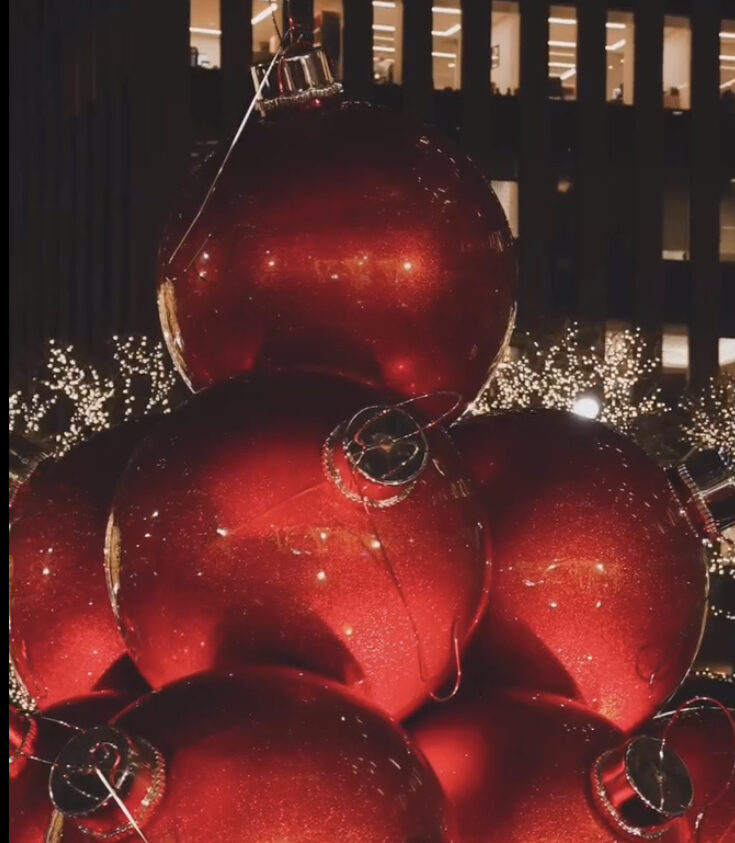
Christmas ornaments on 6th Ave. Image courtesy of NannFilms, used with permission.
LAW FIRM UPDATES AND EVENTS
Firm Founder Listed Again by Chambers
For the second consecutive year, firm founder Leila A. Amineddoleh was recognized by Chambers and Partners High Net Worth Guide for her work in Art and Cultural Property Law. The publication named Leila as an attorney who has “a lot of expertise in the cultural property space,” with “a great courtroom manner.” The publication also remarked on her active presence in the art law space and her work in the litigation area. Read more here. Leila was also named one of the “Top 10 Most Influential Art and Cultural Property Law Lawyers in 2023” by Business Today. For that award, Leila was selected for her “unique touch of fervor to her work, combined with a comprehensive understanding of art law.” Read more about that award here.
Art Law Conferences
Congratulations to our firm’s founder Leila A. Amineddoleh, who successfully chaired the 15th Annual NYCLA Art Law Institute, one of the most anticipated events of the year. Leila also moderated a fascinating panel during the event entitled “Broken Promises: Promised Gifts and Legal Enforceability.” A major theme in the panel was for lawyers to be extremely aware of the time between the time the gift was made, and the time the gift is executed (word to the wise: things can change!).
Yelena Ambartsumian gave a presentation at the conference with Claudia Quinones, one of our former associates (and current friend). The two gave thoughtful insight and wisdom on issues surrounding title and authenticity.

Santa Con NYC in Central Park. Image courtesy of Nycmstar, used with permission.
IN THE PRESS
Leila appeared in the Washington Post and in an article for ABC News this year, in addition to other notable publications. In each, she was consulted as an expert voice on a variety of art and cultural heritage law topics, including discussions on the ethical implications of resolving cultural antiquities ownership disputes.
Additionally, Leila was invited to contribute to the Third Edition of The Art Law Review. Her article, “Cultural Heritage Disputes and Restitution” examines Nazi-looted art disputes, antiquities litigations, government seizures, and ethical concerns related to the acquisition and display of Colonial-era takings. Read more here. Another of Leila’s scholarly publications, “Kings, Treasures, and Looting: The Evolution of Sovereign Immunity and the Foreign Sovereign Immunities Act,” was published in the Columbia Journal of Law & the Arts. Read more here.
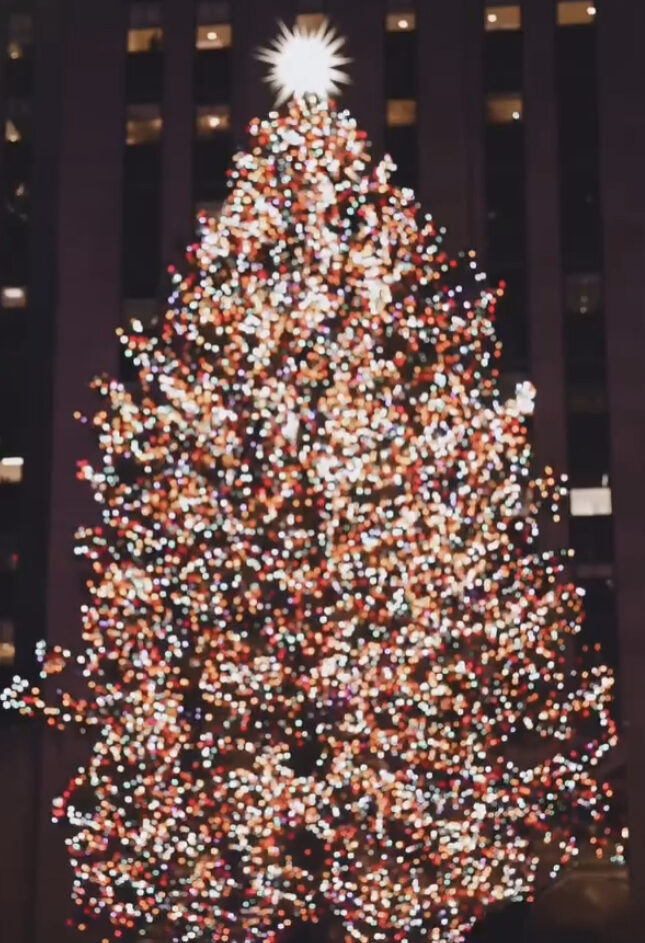
Christmas tree at Rockefeller Center. Image courtesy of NannFilms, used with permission.
Leila also was featured in New York Metro Super Lawyers Magazine as a leader in her field. For the article, Leila’s was highlighted as an exemplary, top-rated intellectual property, art, and cultural heritage lawyer well-known in the industry for getting the job done right. Read more here. Leila was also the feature story in Boston College Magazine’s Winter 2023 issue. The story followed Leila’s art law career along with the story of the looted marble bust that was restituted to Germany in 2022. Read more here.
Maria T. Cannon contributed several letters to the Wall Street Journal this past year on AI and the ethical implications of attorneys and artists. She was also published in the ABA’s Art & Cultural Heritage Law Newsletter, Spring 2023 Edition. You can read it here. She also presented two lectures this past year. The first was in Asheville, NC, about the challenges attorneys face when dealing with celebrity-inspired art. Read more here. The second was at Cardinal Gibbons High School on Nazi-looted art. Finally, she completed Artificial Intelligence Governance Professional training through internationally-recognized leader in privacy, information, and cybersecurity law, IAPP.

White birch forest. Artwork courtesy of Justin Leitner, used with permission.
On behalf of Amineddoleh & Associates, we wish you a happy and healthy holiday season and a wonderful and prosperous new year.
P.S. Click here for one last special holiday message from our firm!
by Amineddoleh & Associates LLC | Dec 7, 2023 |
It’s official – The Gingerbread City has come to New York.

The Gingerbread City’s futuristic cityscape. Image via The Seaport.
Residents of FiDi are already in-the-know and can reportedly smell the cookie houses throughout their neighborhood. A miniature city of futuristic houses entirely constructed of gingerbread and candy is on display at the Seaport – with gingerbread baked courtesy of Balthazar. These professionally-built cityscapes are easily mistaken for pricey works of art. Premier architectural minds used their applied their training to produce a verifiable wonderland of delicious fun.
Those wandering the candy-cane lanes at The Gingerbread City in NYC may wonder where all of this gingerbread madness started – and when the qualifications for a “good” gingerbread house maker suddenly amounted to the same as those required of a minor Renaissance master.
Gingerbread houses are not a new phenomenon, but the artistry behind them is a modern cultural trend. The earliest villages of cookie-built houses originated in Germany, inspired by fairytales.
History of Gingerbread Houses
Remember the story of Hansel and Gretel? Apart from being a harrowing tale told to young children (teaching kids to – above all – never leave crumbs on the floor), the story is supposedly responsible for candy-constructed houses. The original 1880s fairytale reads: “When they [Hansel and Gretel] came nearer, they saw that the house was built of bread, and roofed with cakes, and the window was of transparent sugar.” Alternate translations referred to the “bread” as “gingerbread.” This was great news for German bakers, who were already well-versed in the art of lebkuchen, or “spiced-honey biscuit”-making. They took the Grimms’ cue and ran with it, creating delectable confections of miniature houses with cookie walls, held together by frosting.

Hansel and Gretel. Image via A Child’s Book of Stories (1911), public domain.
Centuries later, bakers around the world still construct houses that look (and usually are) good enough to eat. However, in modern times, yearly competitions have raised the stakes. Take, for example, the Annual National Gingerbread House Contest at Asheville, NC’s Grove Park Inn. That nation-wide conference culminates in a display of hundreds of incredibly detailed and awe-inspiring works of culinary magic. Each house is more than a cobble of cookies and candy – it is a work of art.
Modern Bakers Take the Cake
To come out on top at the Grove Park Inn, contestants must go beyond the traditional gingerbread house. Instead, winners in each category shine with their originality and ingenuity. This past year, judges mulled over 200 entries from twenty-two states and Guatemala to choose the winners. Adult, teens, youth and children battled in out in the sweetest battle outside of Cupcake Wars. Winners walked away with more than just bragging rights. At the end of the day, over $40,000 in cash and prizes was up for grabs.

A traditional gingerbread house. image courtesy of Marit & Toomas Hinnosaar via Wikimedia Commons.
Entrants were scored on metrics appropriate to the task at hand. These includes “Best Use of Color,” “Best Use of Sprinkles,” “Most Unique Ingredient,” “Pop Culture Star,” “Most Innovative Structure,” and “Longest Standing Competitor.” Each gingerbread house was required to be constructed of 5% gingerbread and be 100% edible – no small feat, considering the vast majority of these houses looked like they came out of an artist’s studio, not a kitchen.
Skeptical? Just consider this year’s grand-prize winner – a mini Indonesian-inspired dwelling entitled “Christmas at the Tonkonan” built by an aunt-and-niece duo. The breathtaking piece includes a lattice room, palm fronds, detailed “woodwork”, and tiny home-dwellers – ready to celebrate the holiday of their little lifetimes.
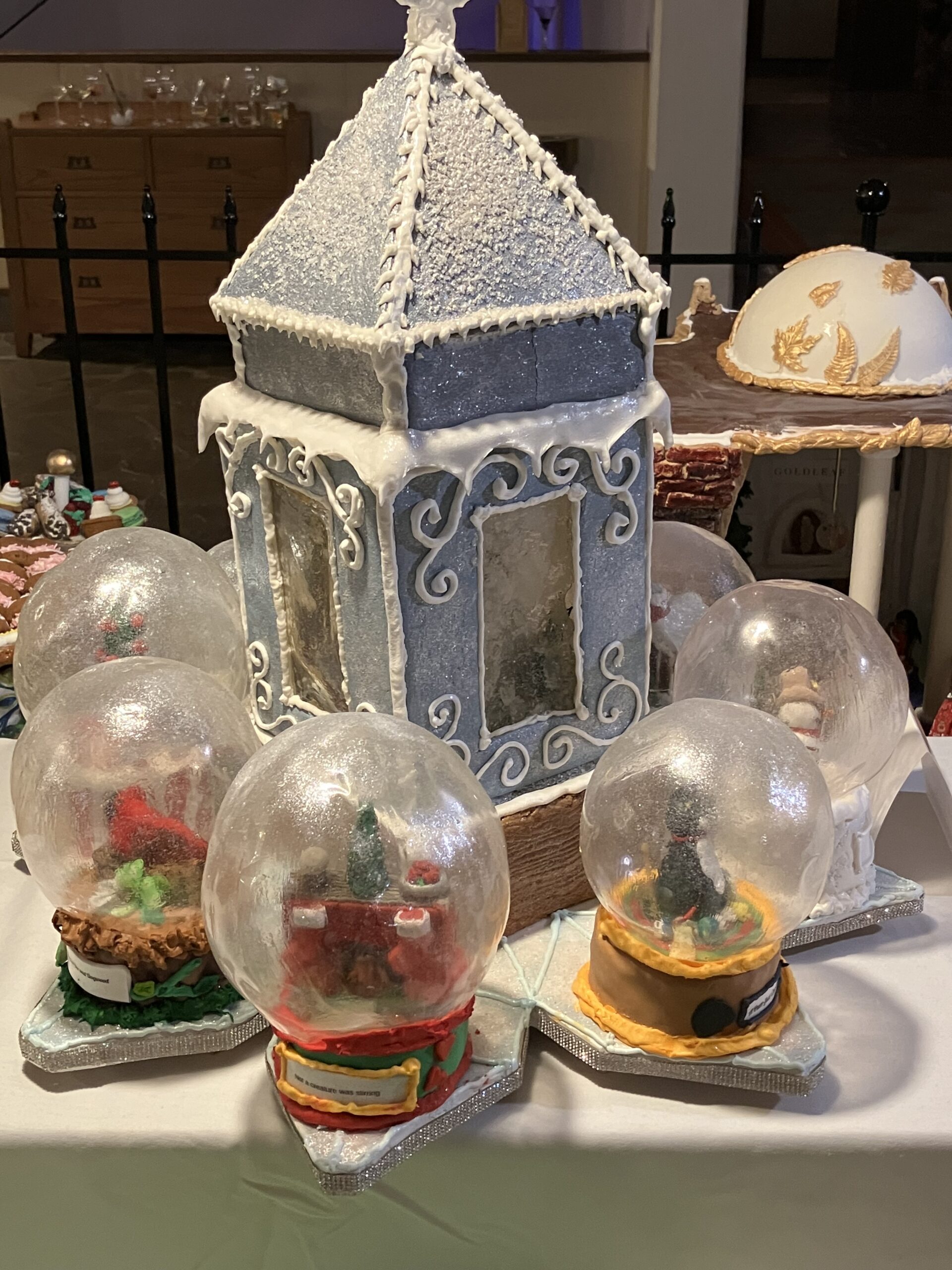
A snow globe themed entry at the 31st Annual National Gingerbread House Competition hosted by the Omni Grove Park. Image courtesy of Maria Cannon, used with permission.
The houses at the Grove Park – while unbelievably beautiful – do stray from the traditional gingerbread house form. Those looking for a more traditional (yet still impressive) way to whet their gingerbread house appetite this year can look no further than the life-size gingerbread house at the Fairmont Hotel in San Francisco.
Life-Size Gingerbread House
It’s true – not only is the Fairmont the former haunt of famed San Franciscan artist Leroy Neiman (who was known to doodle on menus while waiting to be served at tea), it is also the West Coast’s Christmas Central.
Dubbed “Festive Holidays at the Fairmont,” guests can enjoy all sorts of holiday hoopla. However, the real stunner is the life-size gingerbread house in the lobby. Constructed of hundreds of bricks made by staff pastry chefs, this house is the one all the gingerbread men on the block are clamoring to move into. (You thought the New York housing market was rough? Try finding real estate fit for life as a cookie.)

Life-size gingerbread house at the Fairmont Hotel in San Francisco. Image via Fairmont San Francisco.
At the Fairmont, the gingerbread house is not for sale – and no prizes are awarded – but lucky guests may score the chance to tour the inside of the house. Jury’s out as to whether anyone has actually been brave enough to take a bite out of the walls while on the private tour, but hotel staff claims that they have seen guests pawing at the pounds of See’s Candies adorning the windowsills.
Gingerbread Decorating Is The New Culinary Art
Whether big or small, the culinary confections bakers are turning out this time of year deserve our appreciation and recognition. The time, talent, and craft that is required to decorate houses of this detail and magnitude is nothing short of artistic genius. In fact, according to the Culinary Institute of America (CIA), art courses are now a required component of educational programs for master pastry chefs. The class is called “Principles of Design” and the syllabus reads like it’s straight out of Parsons – students learn how to shade, combine colors, plan, sketch and create art across multiple media.
Other modern artists and designers have taken this as a cue to apply their skills (honed in traditional artistic settings) to the art of pastry decorating, including gingerbread house making. Last year, designer Kelly Wearstler and Richard Christiansen (owner of the luxe Flamingo Estate) collaborated with Balthazar’s pastry chef, Mark Tasker, to create a limited-edition gingerbread house offering. Only 100 houses were produced, and proceeds from the (substantial) sales price went to Structure, a charitable initiative that helps communities rebuild sustainable houses after natural disasters.

Kelly Wearstler’s gingerbread creation. Image via Flamingo Estate.
The unique house – done in Kelly Wearstler’s signature California Modernist style – looked like it belonged in California in the 1940s. The innovative design featured a checked exterior and clean, architectural lines. In short, it was iconic and bold, and lived up to the hype of her stated intention prior to starting the project, which was to “build a type of gingerbread house [she and Christiansen] would actually like to live in.”
Wearstler’s design, combined with Tasker’s skill as a baker, fueled holiday magic in the most delicious of forms. The pair created art fit for auction at Sotheby’s, or for display in any art museum in New York or L.A.. Wearstler found the process so intriguing and inspiring from a design perspective that she applauded the gingerbread base as being “the ideal canvas” for her vision to take shape.
At this time of year, and especially in the face of the modern political, economical, and environmental crises impacting our communities, there is something so valuable about the act of taking time to experience art in all its festive forms. For gingerbread house artists, the entire process is akin to artistic masters hard at work in-studio. Here’s to the gingerbread house bakers – the amateur and the masters – who bring us all to stop and wonder at their art of baking.
Want to try your own hand at baking a gingerbread house? Click here for King Arthur Baking’s “construction gingerbread” recipe.
Rather buy your own, already-crafted work of edible art? Look no further than Solvang Bakery‘s creations.
by Amineddoleh & Associates LLC | Oct 31, 2023 |
Good news, thrill-seekers! Here at Amineddoleh & Assoc., not only do we provide exquisite legal services for our clients, we also know where to find a good, real-life scare. Our secret? Follow the haunted art!
Read on for our recap of our firm’s top haunted art-themed blog posts. Then, book a ticket to see the haunted art in-person. No tricks here, each destination is a true, Halloween treat.
Witch Way to the Party?
In this recent blog post, our firm traveled to Asheville, NC to get a glimpse at America’s Largest Home – and one of the most haunted. Click the link for all the details on this spooky mansion, including its most famous ghost-in-residence. Not only that, this historic home has a strange room known as the Halloween Room for visitors to experience, plus its own secret connection to protecting American art from Nazi air-raids in WWII. As if that weren’t enough to encourage a click, this post also has dazzling photos of Asheville’s gorgeous fall foliage.

Biltmore House in Autumn. Image via R.L. Terry at Wikimedia Commons.
The Ghoulishly Gory Frescos in Rome’s Santo Stefano Rotondo
Ever see art so gory it incites a physical response? Click here for more info on this real-life syndrome, known as Stendhal Syndrome, in which grotesque art and cultural heritage causes viewers to have palpitations of the heart. For those wanting to experience the syndrome in real-life, look no further than Santo Stefano Rotondo in Rome. While most tourists on a Roman holiday select beautiful frescos at the Vatican, those who venture to Santo Stefano will see a different sort of religious art. Go for the scenes of torture, stay for the bloody depictions of senseless violence. Plan to go before lunch, or else risk spilling the contents of your own stomach at the foot of these cultural works.

Gory frescoes covering the walls of the church. Image courtesy of Leila Amineddoleh, used with permission.
Cursed Art, from Statues to Paintings
Anglophiles, unite! The National Gallery in London is home to one of the most famous paintings in the world. However, this work is not famous for its artistic qualities (though they are divine). Rather, The Rokeby Venus is better-known for its ability to cause viewers to lose their minds. Click here to read all about this painting’s astonishing – and potentially cursed – provenance. The strange stories behind The Rokeby Venus illustrate how all aspects of a work’s life – including whether or not it is cursed – create its provenance. No matter what your opinion is of The Rokeby Venus’ alleged curse, the documented history of strange occurrences attributed to its ownership has become an important part of the work’s provenance.
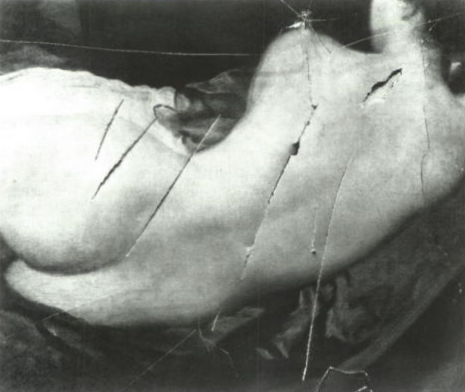
The slashed Rokeby Venus. Image via artinsociety.com.
Haunted Happenings: The Law of Ghosts and Home Sales
If the average Airbnb isn’t scary enough this season, consider visiting a house that’s actually haunted. More and more people are reporting ghosts in domestic settings – and not always friendly ones. Trouble ensues when the place the ghost calls home is up for sale. Lawyers may be faced with the question: is a ghostly presence a condition that must be disclosed prior to sale? Would a reasonable family purchase a house that comes with a frightening ghost? Read more here to discover the actual laws that govern when a family’s new home comes with an unexpected side of ghost.
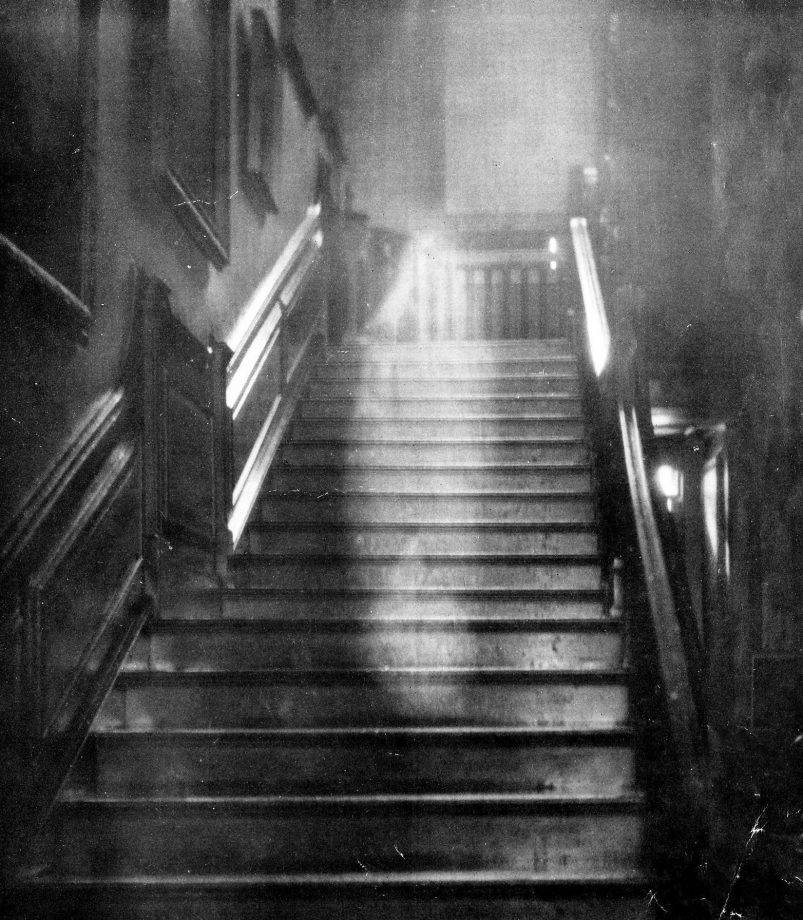
Famous ghost photograph of the Brown Lady of Raynham Hall, originally taken for Country Life (first published in December 1936).
Horrifying Provenance of Monster Manuscripts
This post provides two monstrous holiday destinations in one spooky swoop: ties to Mary Wollstonecraft Shelley’s Frankenstein can be found in both New York City and Oxford, England. Online versions of Shelley’s copious notes and edits for the story can be found on The Shelley-Godwin Archive’s website through the New York Public Library. To pay a visit to the originals, travel to Oxford, where the original transcript are held as part of the Abinger Collection in the Bodleian Library. If that weren’t reason enough to visit Oxford this time of year, stop by Christ Church College for the Harry Potter-esque tour of the storied grounds. Glimpse the inspiration for the wizarding world’s tall towers and cavernous halls on the college campus. Who knows – wizards also might be walking the grounds, masked in their muggle clothes.
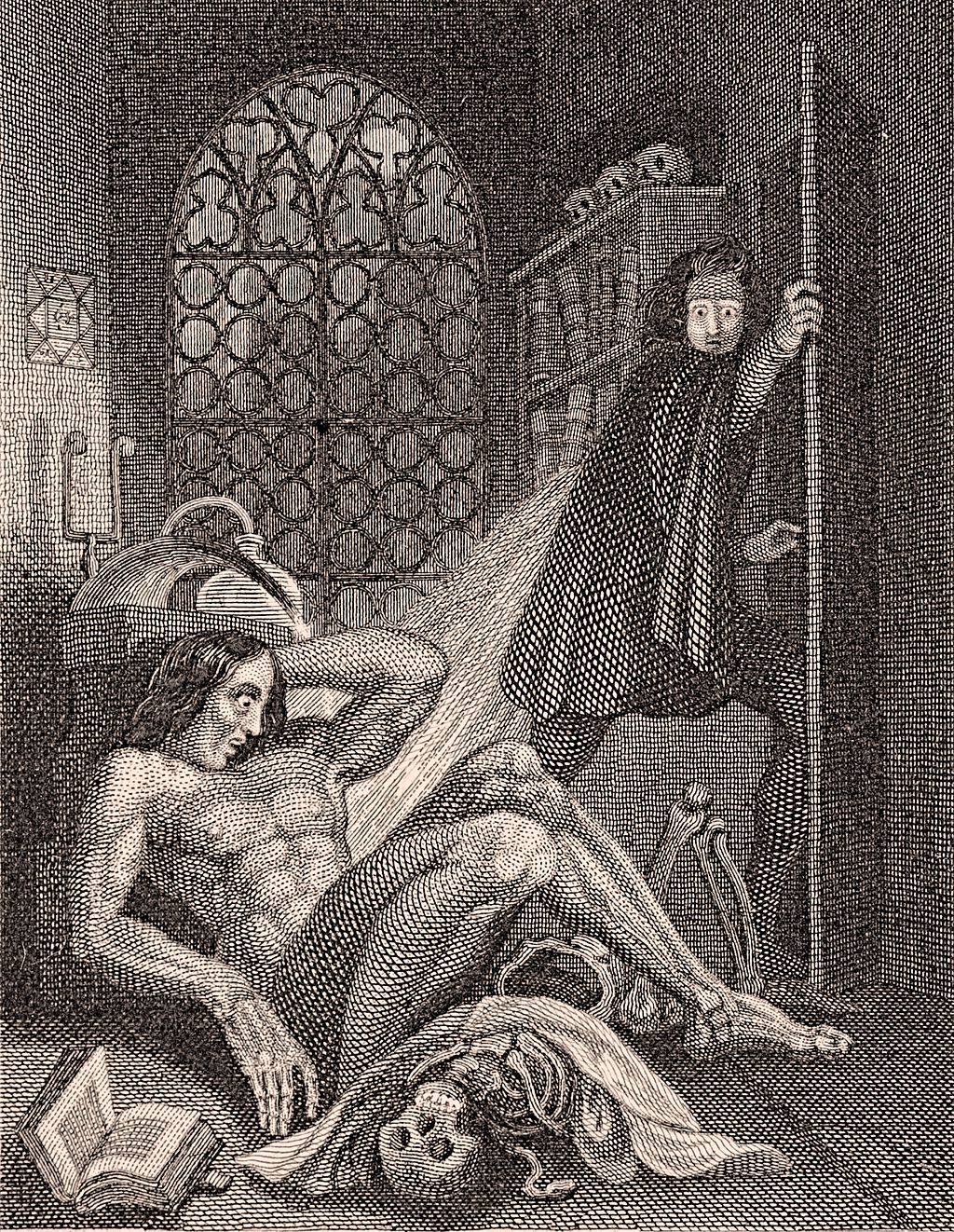
Illustration from the frontispiece of the 1831 revised edition of Frankenstein, published by Colburn and Bentley, London 1831.
The Cat’s Meow: Feline Art Lovers
Word on the street is that the husband of our firm’s founder is dressing as a cat for the second consecutive year this Halloween. While we can neither confirm nor deny the Halloween costumes of our firm’s families (or whether or not, in fact, the members of those families were given the freedom to select their own costumes, or if they were selected for them by their young daughters), click here for a post inspired by our culture’s love for cats in art. Thinking of dressing as a cat this year? As our founder’s husband may say, ‘tis the season!
On behalf of Amineddoleh & Associates, we wish you a safe and Happy Halloween this year!
by Amineddoleh & Associates LLC | Oct 26, 2023 |
Congratulations to our firm’s founder, Leila Amineddoleh, who successfully chaired the 15th Annual NYCLA Art Law Institute: New Insights in Art Law. This annual conference is one of the most highly-anticipated and innovative events of the year.

Peak fall foliage in NYC’s Central Park, just in time for the Conference. Image via Central Park Conservatory.
This year’s was no exception. The two-day event highlighted leading experts and voices in the our industry. Read below to get a glimpse of how panelists dove into the hottest topics facing artists and lawyers today – they dove into a wide array of topics, including evolving issues in the art market, art and cultural heritage law, and intellectual property.
New Developments, Dispute Resolution, & Art World Conflicts of Interest
Day 1 opened with a smash-hit panel. The panel, featuring Paul Cossu, Adrienne R. Fields, and Claudia Quinones, tackled new developments in art law and intellectual property. One highlight from this panel was the intersection of AI-created art and copyright law. A takeaway was that the U.S. Copyright Office tends to make decisions related to AI-created art based on whether AI was used merely as a tool, or whether AI was the true author.
Next, Gabrielle C. Wilson moderated a fascinating panel on resolving art disputes. The panel pondered the critical considerations and alternatives when resolving art disputes. This panel presented attendees with multiple, practical paths to use when dealing with these controversies. In some situations, art attorneys may find greater success by encouraging negotiation between parties, rather than pursuing litigation. As a whole, this second panel was a good reminder for art lawyers to continue to lean on their specific expertise in the art world to help both side achieve a just and equitable solution.
Finally, Katherine Wilson-Milne moderated a panel on art world conflicts of interest. The panel explored ways to approach these conflicts, including some suggestions for innovative paths forward. This panel encouraged participants to broaden their perception as to where art world conflicts may come from in subsequent years. With so many aspects of the cultural, financial, and political climate in flux, the art industry is being directly and indirectly impacted. It is essential for attorneys to be aware of new developments in art world conflicts of interest, and ways to best address them as they arise.
Title and Authenticity, Broken Promises, & Artist Residences
Day 2 narrowed the Conference’s focus even more precisely. The day started off with our firm’s own Yelena Ambartsumian’s presentation with Claudia Quinones. The two gave thoughtful insight and wisdom on issues surrounding title and authenticity. One highlight from Claudia’s portion included the latest developments in Nazi-looted artwork. She drew attention to the most essential cases to watch in the coming months, and provided great detail as to the specific laws at issue in each case.
Yelena then dove into powerful issues regarding cultural heritage. She brought specific attention to Armenian cultural heritage, and the current risk for destruction of such treasures. Yelena also explained the legal paths the Republic of Armenia has taken to protect their cultural heritage, due to a lack of UNESCO involvement. She also gave phenomenal insight into the hot top of authenticity issues. One takeaway from that aspect of her presentation is that, if there are reasons to be skeptical about the authenticity of a work of art, it is a good idea for the attorney to explore those suspicions!
Next up, our founder Leila moderated a fascinating panel on the enforceability of promised gifts and what happens when circumstances change. The length of time between the time the gift was made, and the time the gift is executed, was a major theme in this panel. The panel also parsed through the diverse scenarios that arise when receiving monetary gifts versus physical collections of art. In terms of physical artwork, the cost of conservation was also highlighted as an important factor in whether or not a museum or institution is even able to properly receive a certain gift. This point is especially poignant in the industry’s current climate, as costs of conservation continue to rise alongside other financial needs of leading institutions.
Melissa Passman wrapped up the day by moderating the final panel of the Conference. This closing panel explored artist residence issues, and how to navigate founder and participant relationships. One takeaway was that the resources made available to artists in these relationships tend to drive the residency as a whole. As a result, it’s important for attorneys involved to be aware of the specialized spaces and studios that may be necessary. Otherwise, it would be impossible for the artists to work and fulfill the terms of their residencies. Another takeaway was that tax laws tend to dictate what non-profit organizations are able to accomplish in these relationships. Because this could complicate artist payment in residencies, it is necessary for lawyers working with these clients to be well-aware of tax obligations, and to make that a driving factor in negotiating agreements.
Another great year!
In all, attendees experienced two action-packed days of practical advice and innovative guidance. Our firm commends all of the presenters for their hard work and fascinating presentations. We look forward to this conference each year, and this year’s was truly a celebration of the best, boldest, and brightest minds in our ever-evolving field.
Let the record stand that peak fall foliage in Central Park has its perks, but the real highlight of October in NYC is the Annual Art Law Institute.
P.S. Missed the Conference? Get in touch with NYCLA here to purchase the recording when it is released.


















